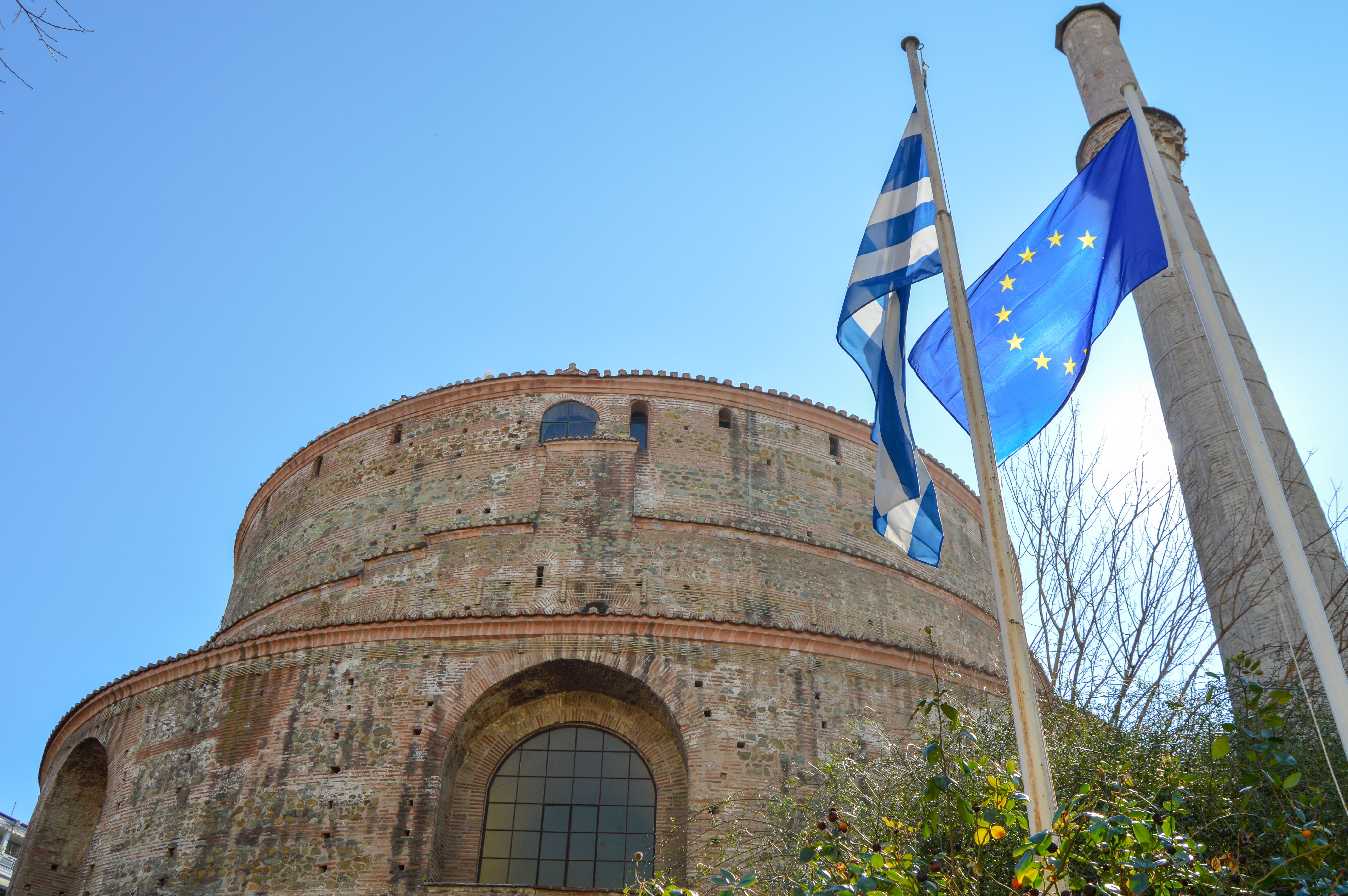
Rotunda, Thessaloniki
Thessaloniki is about 5 hours away from Pristina and it seems like an easy trip to take. However, Kosovo is not a member of the European Union nor Schengen Zone. Therefore, its citizens have to apply for a visa to take this short trip away.
At the end of November last year, the Greek Liaison Office in Pristina scheduled my visa appointment for early February. My interview was like an interrogation, in which the Office employee made me feel like a criminal or a potential fugitive. I’m sure many Kosovo citizens feel like that every day in foreign embassies. In the end, I was told to go back in two weeks to collect my passport (and perhaps the visa). I went back as required to collect my passport and had mixed feelings when I saw the visa on my passport. Knowing that there have been many cases lately when people have been rejected visas on no strong basis whatsoever or others who have been granted a visa only for the few days they had already paid the accommodation for, I should have been happy I got my multi-entry visa for three months (with 21 days allowed to be spent within the European Union but Spain which does not recognize Kosovo nor its passports). However, having had many visas before, the three latest ones being one-year ones and having a valid US visa for three years and a few others such as a UK, Thailand, and Jordan visa, I was truly surprised I wasn’t issued a longer visa.
Anyway, I got my visa and the next day I was to leave for Thessaloniki. Then, it seemed like mission impossible when I understood that the bus running between Skopje and Thessaloniki has been canceled. I was also considering doing the trip by bus early morning from Pristina to Skopje and then heading to Gevgelija. From there I was hoping to find a taxi or a bus or hitchhike (at the very end, although it’s not something I want to do). The other option was going to Tirana and then taking a bus to Thessaloniki from there which was more costly and lengthy in time, but a better option than hitchhiking. So, something which should have been a piece of cake turned into a saga and at some point, I was reconsidering going there at all. With the help of social media, two sisters, who had to travel the same dates as I did, found me and finally they could arrange a taxi for us which proved to be the best choice.
Few Greek words to know
As in all countries, it helps if you know some basic expressions in the local language. The expression “it’s all Greek to me” was literally true throughout my trip (with the exception of the few words below). I managed to learn some words in Greek and used them every time when appropriate. The words such as nai (yes) or oxi (no), kaliméra (good morning), kalispéra (good evening), yamás (cheers), efcharistó (thank you), and parakaló (you’re welcome).
Top things to do in Thessaloniki
1. Take a free walking tour (or two)
Giorgos Semkos, from Thessaloniki Free Walking Tours, organizes two walking tours in Thessaloniki – one for the Upper Part of the City and one for Downtown or City Centre. I took the City Centre tour with him and if I had to sum it up in few words I’d say I loved it. He did a great job in showing us around and taking us to hidden places (and telling us about other ones), explaining the history of the city, the crisis and how Greece came to that situation, and other areas which otherwise I wouldn’t have found on my own.
If you are in Thessaloniki for the first time, this walking tour is a good start to give you ideas on where to go and what to see. The tour for the city center starts by the Aristoteles statue, whereas the one at the upper part from the Church of Profitis Ilias (check the website for the schedule). At the end of the tour, you get a free map customized with the points of your interest and can also leave your tip to Giorgos.
2. Visit the Arch of Galerius and Rotunda
The Arch of Galerius is a famous meeting point and also a famous landmark which can’t be missed while in Thessaloniki. It was built in 298 to 299 AD. The Arch had 8 pillars; however, only three of them survived. Rotunda is the other part of this attraction which is not to be missed while in Thessaloniki. Both the exterior and interior were fascinating. Rotunda was initially used as a Christian Church and then when Ottomans occupied Thessaloniki it was turned into a mosque and the minaret was added at that time. In 1912, Greeks took the city back and Rotunda with it and reconsecrated the structure as a church but didn’t remove the minaret. Now the building is a historical monument open to the public and the ticket cost 1 EURO.
3. Visit the White Tower
The White Tower replaced an old fortification that had been mentioned around the 12th century and later was reconstructed during the Ottoman Empire in 1430. The Tower served as a prison in which many people were tortured and executed during the occupation. In 1912, when Greeks regained the city, they whitewashed it and now it is the symbol of the city. Almost all fridge magnets or greeting cards you see from Thessaloniki have the White Tower in them. The Tower is open every day from 8 a.m. to 4 p.m. and the ticket cost 2 EURO. The signs inside the Tower are in the Greek language; however, there are voice guides which you can rent for 8 EURO. At the top of the Tower, you can have a 360 degrees view of the city.
4. Visit the Castle of Thessaloniki
The Castle of Thessaloniki, known also as heptapyrgion or eptapyrgio in modern Greek (and also Yedi Kule according to its Ottoman Turkish name), provides a perfect view of the city. It is located in the Ano Poli, or Upper Town which is the highest part of the old city. All the narrow streets with colorful houses and walls full of graffiti that bring you to the Castle offer a lovely sightseeing despite the uphill. What is worth noting is that the Castle served as a prison until 1989 and then was taken over by the Ministry of Culture and the Byzantine Archaeology service. The entrance was free and the view was lovely, despite the cloudy sky over Thessaloniki on that Monday I visited.
5. Trying Greek food and drinks
Living in Balkans means the access to Greek food and drinks is pretty easy. Nevertheless, the food always tastes much better in the country of origin. Surprisingly, I didn’t take any picture of the food. Not because I didn’t like it, but because I was always so hungry and ate so fast that I forgot about pictures. These two pictures depict some kind of raki I was offered in my first-night dinner and the other picture two other Greek famous drinks – the small glass had rakomelo, a hot alcoholic drink which was very tasty and the big one had retsina. Of course, I had ouzo – who doesn’t when in Greece, right? – and I even took some back home.
6. Finding street art/graffiti
One thing I loved in Thessaloniki was the plentifulness of graffiti and street art all over the city. As my style of sightseeing is most of the times getting purposely lost in the city, I loved just wandering around and “finding” the art all over. Stickers, paintings, sayings, and graffiti – they all caught my eye and my camera lens.
7. Catching a sunset by the sea
I read recently somewhere that “sunsets are a proof that not all endings are bad”. I loved walking by the sea and looking at the sunset colors. It’s such a perfect view, one I can never get tired of. Even with a cloudy sky, the sunset looked still beautiful.
8. Taking a boat tour
While in Thessaloniki you can take a boat tour which will last for 30 minutes and will take you around the gulf. The entrance to the boat is free if you choose to buy a drink or you can pay the 3 EURO ticket only (this is for the Arabella boat). I took the tour at 5 p.m. which was just the beginning of the golden hour which put a lovely light on the buildings.
9. Visit the Church of Hosios David
From the Castle of Thessaloniki, you can go to the Church of Hosios David or known as Moni Latomou, which is a UNESCO World Heritage Site. This is a church from the late 5th century which under Ottoman regime was turned into a mosque and the famous mosaic was plastered. The mosaic of Theophany depicts Christ holding a text in the Greek language.
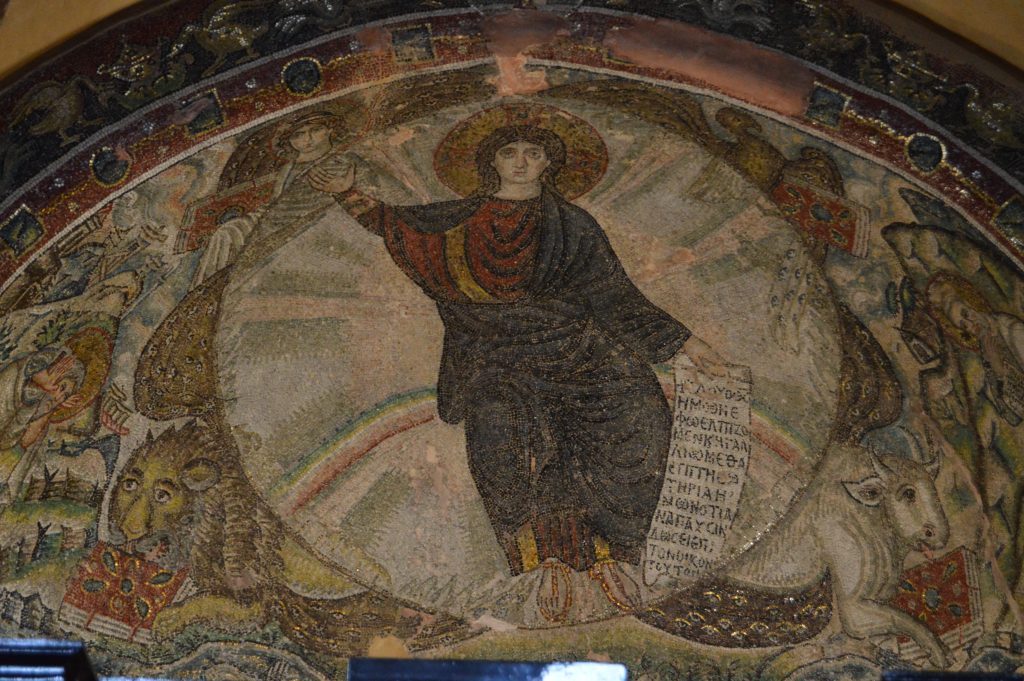
10. Hanging out with locals and other tourists/travelers
I was eating on my own in one of the taverns near the hostel, called To Igglis, when a Greek lady, Rania (hopefully I’m spelling her name correctly), came to my table and invited me to join their table. I was hesitating as I thought they’d have to switch to English – which happens in Kosovo whenever one foreigner joins a group of Albanians – but she insisted saying she can’t see anyone eating alone so I joined them. There was lots of laughter and some language exchange and plenty of yamás during those hours. Being from Kosovo among people whose country hasn’t recognized mine yet made me hesitate, but with a couple of glasses of raki, countries didn’t matter anymore.
At the hostel I was staying, there were many internationals and I made friends with a couple of them with whom we went eating to Stase and another tavern near our hostel, drinking at some bars, and sightseeing around the Upper Part. It’s always interesting to meet other travelers/tourists and as I am from Kosovo and not many people know about my country, I always have to teach them our history, geography, culture and what not. I’m not complaining, I love talking to people and exchanging knowledge.
11. Loving all the cats you see on streets
If I was living in Thessaloniki and I had to meet someone, I’d have to add at least 10 more minutes to my walk for all the lovely cats I’d encounter on my way. I saw so many cats there which in a way reminded me of Istanbul, and I was impressed by some of them which would take a pose when they saw me taking a picture of them. The plus in photographing cats (or other animals) is that they don’t ask to see the picture and never complain about how they look. They were also ready to jump in my lap and ask for some love whenever I’d sit somewhere. They were so adorable and as a cat person, I found this as one more reason to recommend Thessaloniki to everyone who loves cats too.
12. Walk by the sea
Walking by the sea, to me, is the most peaceful activity I can think of (okay, maybe being in the desert can top that). It gets crowded in Thessaloniki; however, I still recommend you to do it. While walking by the sea you can also make some stops, either in the bars, restaurants, and cafés opposite the sea or the attractions alongside it. You can walk by the Aristoteles Square and visit the Aristoteles Statue; you can stop by the statue of Alexander the Great, and of course the White Tower. In addition, you can visit the Umbrellas which has become also one of the symbols of Thessaloniki.
13. Don’t miss the peacocks and other animals at Vlatádon Monastery
Apart from visiting the Vlatádon Monastery, don’t miss the animals they keep there. In particular, the peacocks looked impressive. One of them even gave a show to us and I could take these few pictures. The view from up there is also a spectacular one, so make time to stop by.
BONUS ATTRACTION FOR ALBANIANS AND ANYONE INTERESTED IN THE ALBANIAN HISTORY
House of Hasan Prishtina
I only had the name of the street where Hasan Prishtina’s house was and it looked like mission impossible. But before telling you the story and how did I find it, let me tell you who Hasan Prishtina was. He was an Albanian politician born in Vushtrri, Kosovo and served as the 8th Prime Minister of Albania in 1921. He was originally known as Hasan Berisha but changed his name in 1908 when he was elected as a delegate from Pristina.
Hasan Prishtina attended the French Gymnasium in Thessaloniki and then studied politics and law in Istanbul. During the Ottoman regime in Albania, when Albanians’ rights were not respected he started his political career by organizing the Albanian National Movement. Until August 1912, he led Albanians in the Vilayet of Kosovo to gain its control from Ottomans, while in 1913 – after Albania Independence – served as Minister of Agriculture and next year as Minister of Postal Services. He served in other political positions and his Prime Minister role didn’t last more than 5 days; however, he is also known as having been rich and having helped Albanians to pursue an education in European universities. When Ahmet Zogu took power in 1924 and Hasan Prishtina couldn’t get back to Kosovo, he went to live in Thessaloniki where he purchased the house I was looking for.
Where to find Hasan Prishtina’s house
Let’s get back to the House of Hasan Prishtina itself. As I said, I only had a street name which was very long and not that much time before it would get dark. So, I put the street name on the map and got a taxi and asked the taxi driver to drop me there. He asked if I had a number and I told him all I had is the name of the street and some pictures of the house. I took off at the point shown by Google maps and decided to just walk towards the city center and watch out for the house from the picture. I walked and also meantime stopped and asked few people if they had seen the mysterious house. At some point, I received contradicting information from two Greeks who thought they’d seen the house but one said I should go right and the other left which produced some laughter among the three of us. Since it was becoming dark and the chances of finding the house in all that long Leoforos Vasilissis Olgas street were small I decided that after 15 minutes of useless wandering, I’d just take a taxi back to the hostel. And as it happens in the movies, just when I had lost my hope and was thinking of getting up earlier the next day (which was my last day in Thessaloniki) and going to the end of the street and then walking all the way to the end of it, I saw the house on the other side of the street. Now the house serves as a School for blind children (or with visual impairment) and access to it is prohibited for the public, but I was only allowed to take some pictures from the outside.
For those who want to see the house in person, the house is in Leoforos Vasilissis Olgas street near Str. Athanasiou Chrisochoou 2-8.
Where to stay in Thessaloniki
I stayed at Little Big House hostel which had an amazing cafe and bar, so cute I could spend hours there if I didn’t have to go around and do some sightseeing. The rooms were also cool (only the shower was small) and the internet not that reliable in the room I stayed at. Their breakfast was very delicious and all the other food they served looked amazing (and I was told tasty). The location was only 20 minutes walk to the White Tower and near the Castle of Thessaloniki and several great taverns where I ended up having amazing food.
I, of course, booked this through Booking.com which I always use when traveling as I am a frequent traveler now (or genius as they call me) and I even got a welcoming drink – the famous Greek Frappe – which I enjoyed under the sunny weather in their terrace. However, you can check some deals below and find your perfect accommodation.
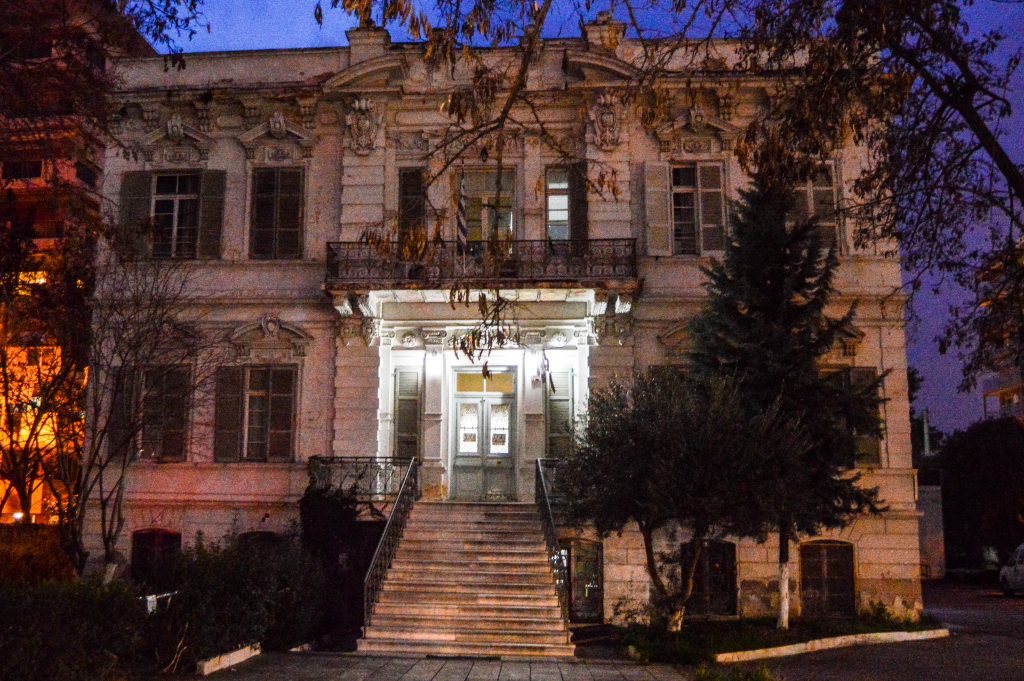
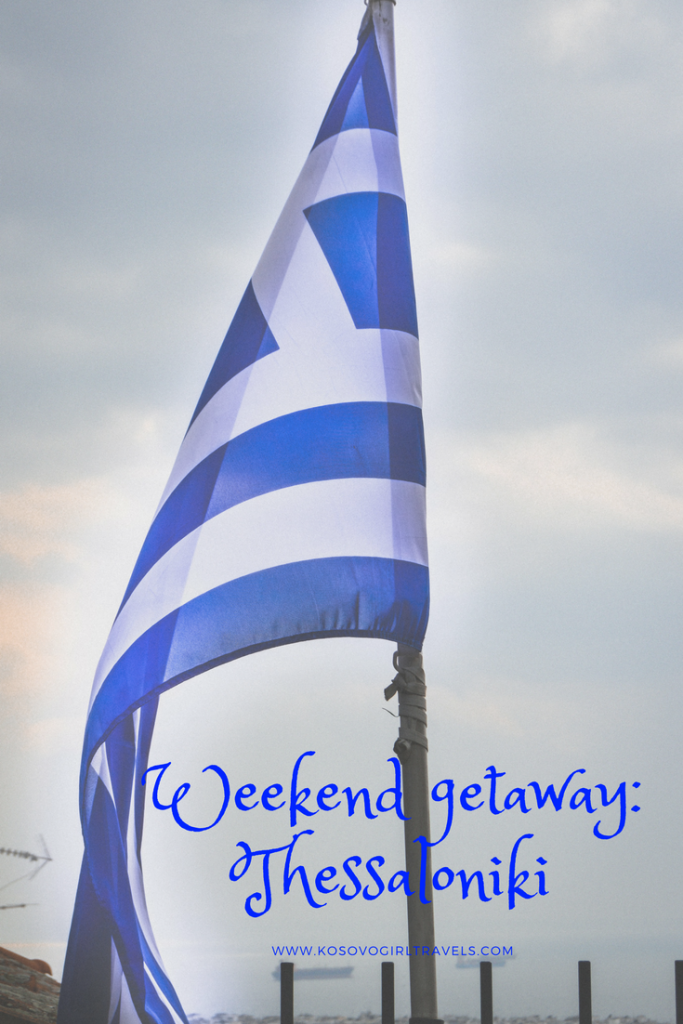
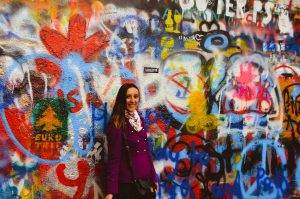
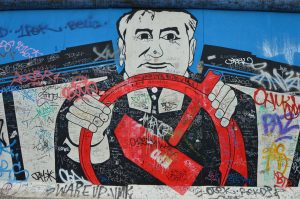
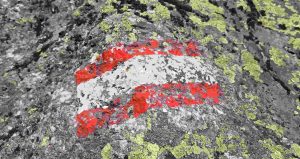

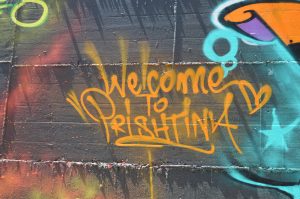

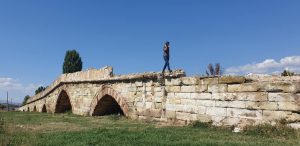
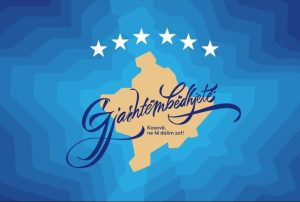
That sounds like the train between Skopje and Thessaloniki is not going anymore either?
What a shame, because that was a really beautiful trip, always along the river.
When I was in Thessaloniki, I had gyros every night. It was so delicious!
I found it a very interesting city with a multicultural history, which is explained quite well at the White Tower.
Hey Andreas,
There was contradicting information about the train and also its schedule is pretty bad for Kosovo citizens (it leaves at 4:45). I’d actually love to take a train ride (although I heard it’s very slow), but I hope I can do it another time 🙂
Gyros are great and generally, all Greek food is tasty.